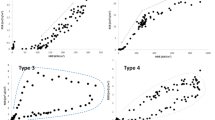Abstract
Many devices have been used to generate data on the toxic potency of smoke from burning products and materials. This paper critically reviews those apparatus and sorts them by the combustion conditions (related to a type of fire) producing the smoke, the specimens tested, and the animal effect measured. All the usable data were derived using rats, and the toxicological effects encountered were lethality, represented by an LC50value, and incapacitation, expressed as an IC50 value. The data showed a wide range of toxic potency values for the products and materials tested. For those engineering applications where the mix of combustibles is unknown, generic values of smoke toxic potency were derived. Statistical analysis of the wealth of published data yielded a generic LC50value of 30 g/m3 ± 20 g/m3 (one standard deviation) for 30 minute exposure of rats for smoke from well-ventilated combustion. There are limited data for underventilated combustion, and a value of 15 g/m3 ± 5 g/m3 is suggested. The mean value of the ratios of IC50 values to LC50values is 0.50 ± 0.21, consistent with a prior review. Thus, for well-ventilated fires, a generic 30 minute IC50 value (for rats) would be 15 g/m3 ± 10 g/m3; for underventilated fires, the corresponding number would be 7 g/m3 ± 2 g/m3. There are some materials with appreciably lower potency values, indicating higher smoke toxicity. If materials like these are expected to comprise a large fraction of the fuel load, a lower generic value should be used.
Similar content being viewed by others
References
B.C. Levin, M. Paabo, and M.M. Birky, Interlaboratory Evaluation of the 1980 Version of the National Bureau of Standards Test Method for Assessing the Acute Inhalation Toxicity of Combustion Products NBSIR 83-2678, National Bureau of Standards, 1983.
D.G. Farrar, ”Comparative Study of the Toxicity of Combustion Products of Tedlar and a Fluorenone-Polyester Film, ”Proceedings, NASA Conference on Fire Resistant Materials National Aeronautics and Space Agency, Washington DC, 1979, pp. 239–250.
R.C. Anderson, P.A. Croce, F.G. Feeley, and J.D. Sakura, Study to Assess the Feasibility of Incorporating Combustion Toxicity Requirements into Building Materials and Furnishing Codes of New York State: Final Report, Volumes I and II and III Arthur D. Little, Inc. Report, Reference 88712, May 1983.
H.L. Kaplan, A.F. Grand, W.G. Switzer, S.C. Gad, ”Acute Inhalation Toxicity of the Smoke Produced by Five Halogenated Polymers,” Journal of Fire Sciences, vol. 2, 1984, pp. 153–172.
V. Babrauskas, B.C. Levin, R.G. Gann, M. Paabo, R.H. Harris, Jr., R.D. Peacock, and S. Yusa, Toxic Potency Measurement for Fire Hazard Analysis, Special Publication 827, National Institute of Standards and Technology, Gaithersburg MD, 1991.
M.M. Birky, M. Paabo, B.C. Levin, S.E.Womble, and D. Malek, Development of Recommended Test Method for Toxicological Assessment of Inhaled Combustion Products. Final Report, “NBSIR 80-2077, National Bureau of Standards, Gaithersburg MD, 1980.
S.J. Williams and F.B. Clarke, ”Combustion Product Toxicity: Dependence on the Mode of Product Generation,” Journal of Fire and Materials, vol. 7, 1983, pp. 96–97.
D.G. Farrar and W.A. Galster, ”Biological End-points for the Assessment of the Toxicity of Products of Combustion of Material,” Journal of Fire and Materials, vol. 4, 1980, pp. 50–58.
B.C. Levin, M. Paabo, M.L. Fultz, C. Bailey, W. Yin, and S.E. Harris, Acute Inhalation Toxicological Evaluation of Combustion Products from Fire-Retarded and Non-Fire Retarded Flexible Polyurethane Foam and Polyester,” NBSIR 83-2719, National Bureau of Standards, Gaithersburg MD, 1983.
B.C. Levin, E. Braun, J.L. Gurman, and M. Paabo, Comparison of the Toxicity of the Combustion Products from a Flexible Polyurethane Foam and a Polyester Fabric Evaluated Separately and Together by the NBS Toxicity Test Method and a Cone Radiant Heater Toxicity Test Apparatus,” NBSIR 86-3457, National Bureau of Standards, Gaithersburg MD, 1986.
V. Babrauskas, R.H. Harris Jr., R.G. Gann, B.C. Levin, B.T. Lee, R.D. Peacock, M. Paabo, W. Twilley, M.F. Yoklavich, and H.M Clark, Fire Hazard Comparison of Fire-Retarded and Non-Fire-Retarded Products, Special Publication 749, National Bureau of Standards, Gaithersburg MD, 1988.
W.J. Potts, T.S. Lederer, and J.F. Quast, ”A Study of the Inhalation Toxicity of Smoke Produced Upon Pyrolysis and Combustion of Polyethylene Foams, Part I. Laboratory Studies,” Journal of Combustion Toxicology, vol. 5, 1978, pp. 408–433.
D.G. Farrar, G.E. Hartzell, T.L. Blank, and W.A. Galster, Development of a Protocol for the Assessment of the Toxicity of Combustion Products Resulting from the Burning of Cellular Plastics, University of Utah Report, UTEC 79/130; RP-75-2-1 Renewal, RP-77-U-5, Salt Lake City, 1979.
E. Braun, R.G. Gann, B.C. Levin, and M. Paabo, “Combustion Product Toxic Potency Measurements: Comparison of a small Scale Test and Real World Fire,” Journal of Fire Sciences, vol. 8, 1990, pp. 63–79.
V. Babrauskas, R.H. Harris, Jr., E. Braun, B.C. Levin, M. Paabo, and R.G. Gann, The Role of Bench-Scale Test Data in Assessing Real-Scale Fire Toxicity, Technical Note 1284, National Institute of Standards and Technology, Gaithersburg MD, 1991.
D.G. Farrar, W.A. Galster, and B.M. Hughes, Toxicological Evaluation of Material Combustion Products. Final Report, University of Utah Report, UTEC 79-141, Salt Lake City, 1979.
G.V. Alexeeff and S.C. Packham, “Use of a Radiant Furnace Fire Model to Evaluate Acute Toxicity of Smoke,” Journal of Fire Sciences, vol. 2, 1984, pp. 306–323.
G.V. Alexeeff, Y.C. Lee, J.A. White, and N.D. Putas, “Use of an Approximate Lethal Exposure Method for Examining the Acute Inhalation Toxicity of Combustion Products,” Journal of Fire Sciences, vol. 4, 1986, pp. 100–112.
Author information
Authors and Affiliations
Rights and permissions
About this article
Cite this article
Neviaser, J.L., Gann, R.G. Evaluation of Toxic Potency Values for Smoke from Products and Materials. Fire Technology 40, 177–199 (2004). https://doi.org/10.1023/B:FIRE.0000016842.67144.12
Issue Date:
DOI: https://doi.org/10.1023/B:FIRE.0000016842.67144.12



